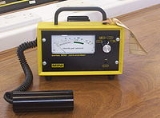
Geiger counter
Overview
Particle detector
In experimental and applied particle physics, nuclear physics, and nuclear engineering, a particle detector, also known as a radiation detector, is a device used to detect, track, and/or identify high-energy particles, such as those produced by nuclear decay, cosmic radiation, or reactions in a...
that measures ionizing radiation
Ionizing radiation
Ionizing radiation is radiation composed of particles that individually have sufficient energy to remove an electron from an atom or molecule. This ionization produces free radicals, which are atoms or molecules containing unpaired electrons...
. They detect the emission of nuclear radiation: alpha particle
Alpha particle
Alpha particles consist of two protons and two neutrons bound together into a particle identical to a helium nucleus, which is classically produced in the process of alpha decay, but may be produced also in other ways and given the same name...
s, beta particle
Beta particle
Beta particles are high-energy, high-speed electrons or positrons emitted by certain types of radioactive nuclei such as potassium-40. The beta particles emitted are a form of ionizing radiation also known as beta rays. The production of beta particles is termed beta decay...
s or gamma ray
Gamma ray
Gamma radiation, also known as gamma rays or hyphenated as gamma-rays and denoted as γ, is electromagnetic radiation of high frequency . Gamma rays are usually naturally produced on Earth by decay of high energy states in atomic nuclei...
s. A Geiger counter detects radiation by ionization produced in a low-pressure gas in a Geiger–Müller tube
Geiger–Müller tube
A Geiger–Müller tube is the sensing element of a Geiger counter instrument that can detect a single particle of ionizing radiation, and typically produce an audible click for each. It was named for Hans Geiger who invented the device in 1908, and Walther Müller who collaborated with Geiger in...
. Each particle detected produces a pulse of current, but the Geiger counter cannot distinguish the energy of the source particles. Invented in 1908, Geiger counters remain popular instruments used for measurements in health, physics, industry, geology and other fields, because they can be made with simple electronic circuits.
Geiger counters are used to detect ionizing radiation, usually beta particles and gamma rays, but certain models can detect alpha particles.
Unanswered Questions

